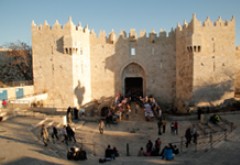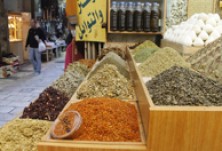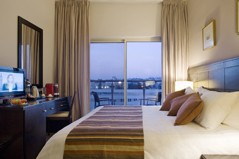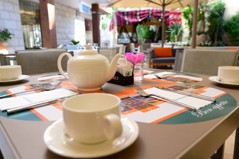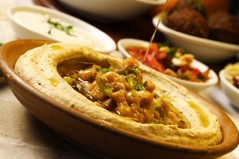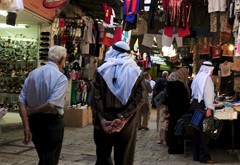Suq Khan al-Zait is the first landmark on this trail. It is recommended to start at the northern end, as this Suq is on the road leading from the intersection a few meters south of Bab al-‘Amud (Damascus Gate) and extends to the Nabi Daoud Gate (Zion Gate) south of the city, crossing the city from north to south.
Suq Names and Sections
During the Roman and Byzantine eras, this road was called the cardo. It was renovated by the Emperor Hadrian in 123 AD and extended to the end of Suq al-Attarin (spice market) today. When Emperor Justinian built the New Church towards the end of the fifth century, he extended the cardo to reach the southern end of the Old City, where the Nabi Daoud Gate is located today. This street is divided into a number of sections, each with a name and specialization. The first section is known as Suq Khan al--Zait (olive oil), extending from the Damascus Gate intersection until the beginning of Suq al-Attarin. Until the middle of the twentieth century, Suq Khan al-Zait had a number of olive presses and soap making facilities. Each press had a large storage area for olive oil; this is most likely the source of the Suq’s name.
Suq Description
Suq Khan al-Zait is a long one, with shops along both sides, and is paved with stone tiles typical of Jerusalem. The first part of this Suq, extending from its northern beginning to just before its intersection with the Christian Quarter Road and ‘Aqabat al-Mufti, is uncovered, while the other parts of this Suq are covered by a stone roof, protecting shoppers from natural elements. The roof cover is characterized by a series of lintels featuring cross-vaults, in the middle of which are large openings for light and ventilation. This architectural fabric most likely dates back to the Mamluk era, although it seems to have been renovated on several occasions afterwards. Suq Khan al-Zaitand Suq al-Attarin, immediately after it, are considered among the most significant features of the Old City. Shops along Suq Khan al-Zaitoffer a large and rich variety of modern consumer goods which cater for the needs of tourists and residents alike, including popular restaurants, confectionery and nut shops, falafel stands, butcheries, vegetable stands and souvenirs. The Suq, however, has lost its traditional specialization of soap manufacturing and olive pressing, given the need to adapt to modern times.
Side Roads from Suq Khan al-Zait
Roads and alleys branch off this Suq, connecting the city’s east and west. These are, from north to south: 'Aqabat al-Battikh westward, and ‘Aqabat al-Tuta opposite it. These old names were mentioned in the Shari’a Court of Jerusalem. Next is the Christian Quarter Road (‘Aqabat al-Khanqa al-Salahiyya), faced by ‘Aqabat al-Mufti Street. This is followed by ‘Aqabat al-Takiyya on the eastern side, faced slightly few meters to the south by the Coptic Monastery (Deir al-Aqbat) and the Sultan Monastery (Deir al-Sultan) roads. Finally, al-Dabbagha Road and the Church of the Holy Sepulcher are faced to the east by ‘Aqabat al-Saraiyya Road.

